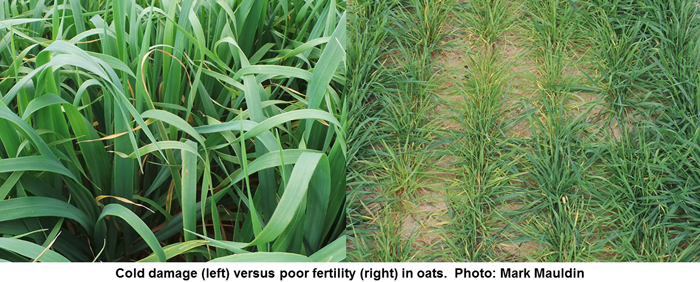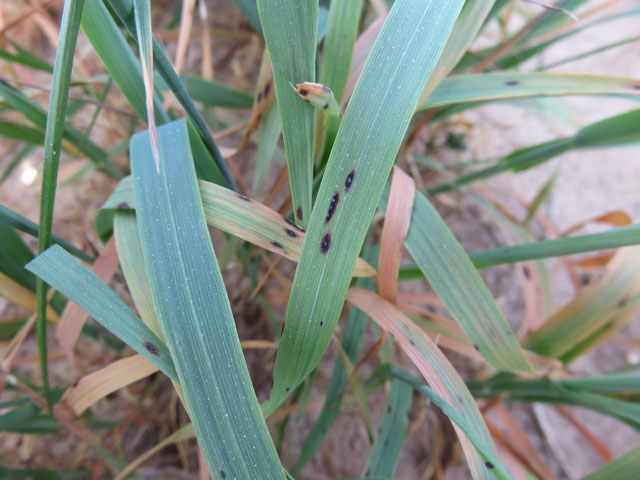Ethan Carter, Crop IPM Regional Agent and Ann Blount, UF/IFAS Forage Breeder
Crop aftershocks related to last week’s weather conditions (cold, overcast, and wet) were felt this week across in the Florida Panhandle. Growers reported a variety of symptoms in their oat fields, ranging from what appeared to be viral discoloration, fungal diseases, and cold damage. It is important for growers to scout fields and be aware of issues early on, rather than waiting until the problem becomes catastrophic.
The recent cold snap has raised concerns in young plants. Areas in a field that were already stunted or lacking fertility, may turn yellow or white from cold damage, not to be confused with Barley Yellow Dwarf Virus which causes similar discoloration, with additional red and orange leaves, and stunting. Barley Yellow Dwarf Virus is vectored by aphids, which are often found in high populations of infected fields. Aphids contract the virus by feeding on infected plants and they transmit the virus to new plants while feeding. Once plants are infected, there is no cure for the virus. Even additional nitrogen applications or insecticides will not help overcome the virus.

 Crown rust (Puccinia coronata), a fungal disease easily identified by the production of bright orange-yellow pustules on the plants has been found in several oat fields in the area. If you are unsure that what you are seeing is rust, wipe the infected tissue to see if the spores smear on contact, or check your pants legs for orange powder, after walking through an infected area of field. In the past two weeks, it has been confirmed in oat fields in Holmes, Gadsden and Jackson Counties. Late last week it also surfaced in the 2016-2017 Cool Season Forage Demonstration Plots in Washington County. The only commercial oat variety currently resistant to rust is Legend 567 (marketed by Mayo Fertilizer).
Crown rust (Puccinia coronata), a fungal disease easily identified by the production of bright orange-yellow pustules on the plants has been found in several oat fields in the area. If you are unsure that what you are seeing is rust, wipe the infected tissue to see if the spores smear on contact, or check your pants legs for orange powder, after walking through an infected area of field. In the past two weeks, it has been confirmed in oat fields in Holmes, Gadsden and Jackson Counties. Late last week it also surfaced in the 2016-2017 Cool Season Forage Demonstration Plots in Washington County. The only commercial oat variety currently resistant to rust is Legend 567 (marketed by Mayo Fertilizer).
Leaf blotch, more commonly known as Helminthosporium or Bipolaris has also been found. This fungal disease is usually associated with poor plant health from stress, often from potash (K) deficiency. It is identified by black spots that form on the plant leaves, sometimes with a tan dot in the center of the infected area.

Leaf Blotch – Helminthosporium or Bipolaris on oats. Photo Credit: Ethan Carter
Management decisions for these issues vary based on the disorder and also the purpose of the oats:
- If desired for forage use, fungal infestations such as rust and Helminthosporium can be grazed off. The fungal spores pose no danger to livestock, but remember excessive grazing will stunt or even kill out the oats. Once grazed down, livestock should be removed, so the field can grow back.
- When growing oats for seed, silage, or haylage fungicides are the best option. Left untreated, rust can decimate an oat field in a matter of weeks. Helminthosporium can also reduce yields, depending on the severity of the disease.
- If fertility is in question, soil samples should be pulled to run diagnostics and determine if any essential nutrients should be applied. When Helminthosporium is often found, K deficiency should be evaluated.
- The best management tactics for Barley Yellow Dwarf and rust prevention is later planting. When the weather is generally cooler aphid reproduction and movement slows down. Rust outbreaks are worse when the disease gets started in early plantings. Rust resistant cultivars are limited on the commercial market, but would save considerable cost by eliminating the need for fungicide applications. Unfortunately this year, with a very warm fall and winter, aphid populations were high. Grazing small grains with heavy aphid populations to reduce their numbers is another approach, as insecticides are not commonly applied in pasture situations. When growing a grain crop for seed, silage or haylage, insecticide applications may be necessary, however this control may not be cost effective.
- 2025 Peanut Field Day Recap & Speaker Handouts - August 29, 2025
- Peanut Foliar Diseases Exploding Across Florida - August 22, 2025
- Provisional Nitrogen Fertilization Recommendation for Florida Cotton for the 2025 Season - June 20, 2025

